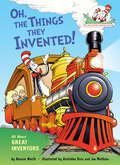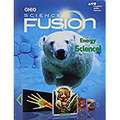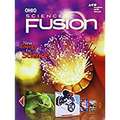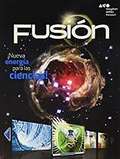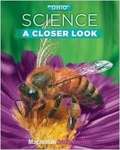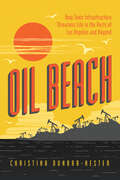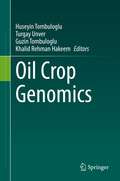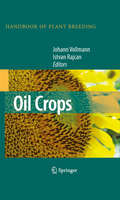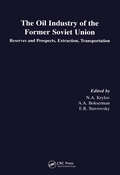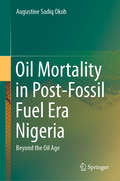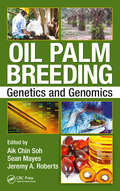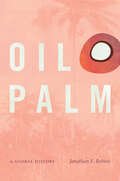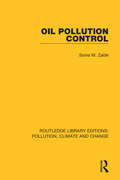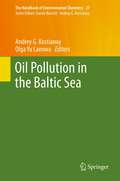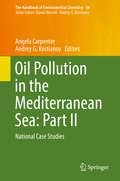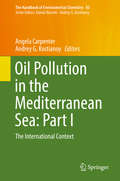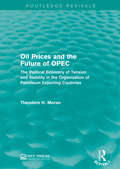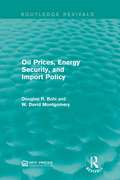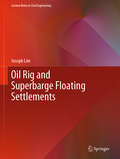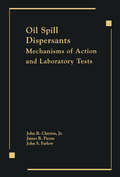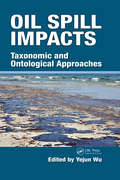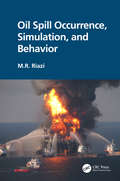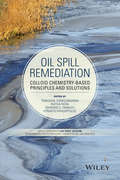- Table View
- List View
Oh, the Things They Invented!: All About Great Inventors (Cat in the Hat's Learning Library)
by Bonnie WorthFrom the first printing press to the World Wide Web—the Cat looks at inventors and inventions that have changed our lives! The Cat in the Hat goes back in time to meet with the masterminds of more than a dozen inventions that made a major impact on our lives today—from famous figures like Thomas Edison, Alexander Graham Bell, and the Wright brothers to lesser-known ones like Garrett Morgan, Mary Anderson, and Tim Berners-Lee. Children will learn basic information about each invention, as well as fascinating facts like how Guttenberg&’s famous printing machine was made from an old wine press, how a steaming teakettle may have inspired the creation of the steam engine, and how table salt changed the history of photography. Ideal for supporting the Common Core State Standards, and a natural for fans of the hit PBS Kids show The Cat in the Hat Knows a Lot About That!, this is a great way to introduce beginning readers to science!
Ohio Interactive Science [Grade 2]
by Michael J. Padilla Don Buckley Zipporah MillerNIMAC-sourced textbook
Ohio Science Fusion
by Holt McdougalCompiled for Ohio New Learning Standards for Science for Grade 7 to build science literacy to enrich your life both in school and later in life.
Ohio Science Fusion [Grade 8]
by Marjorie Frank Michael R. Heithaus Michael A. DispezioNIMAC-sourced textbook
Ohio Science: A Closer Look [Grade 2]
by Jay K. Hackett Richard H. Moyer JoAnne VasquezNIMAC-sourced textbook
Oil Beach: How Toxic Infrastructure Threatens Life in the Ports of Los Angeles and Beyond
by Christina Dunbar-HesterCan the stories of bananas, whales, sea birds, and otters teach us to reconsider the seaport as a place of ecological violence, tied to oil, capital, and trade? San Pedro Bay, which contains the contiguous Ports of Los Angeles and Long Beach, is a significant site for petroleum shipping and refining as well as one of the largest container shipping ports in the world—some forty percent of containerized imports to the United States pass through this so-called America’s Port. It is also ecologically rich. Built atop a land- and waterscape of vital importance to wildlife, the heavily industrialized Los Angeles Harbor contains estuarial wetlands, the LA River mouth, and a marine ecology where colder and warmer Pacific Ocean waters meet. In this compelling interdisciplinary investigation, award-winning author Christina Dunbar-Hester explores the complex relationships among commerce, empire, environment, and the nonhuman life forms of San Pedro Bay over the last fifty years—a period coinciding with the era of modern environmental regulation in the United States. The LA port complex is not simply a local site, Dunbar-Hester argues, but a node in a network that enables the continued expansion of capitalism, propelling trade as it drives the extraction of natural resources, labor violations, pollution, and other harms. Focusing specifically on cetaceans, bananas, sea birds, and otters whose lives are intertwined with the vitality of the port complex itself, Oil Beach reveals how logistics infrastructure threatens ecologies as it circulates goods and capital—and helps us to consider a future where the accumulation of life and the accumulation of capital are not in violent tension.
Oil Crop Genomics
by Khalid Rehman Hakeem Huseyin Tombuloglu Turgay Unver Guzin TombulogluPlants are an important source of fats and oils, which are essential for the human diet. In recent years, genomics of oil biosynthesis in plants have attracted great interest, especially in high oil-bearing plants, such as sesame, olive, sunflower, and palm. Considering that, genome sequencing projects of these plants have been undertaken with the help of advanced genomics tools such as next generation sequencing. Several genome sequencing projects of oil crops are in progress and many others are en route. In addition to genome information, advanced genomics approaches are discussed such as transcriptomics, genomics-assisted breeding, genome-wide association study (GWAS), genotyping by sequencing (GBS), and CRISPR. These have all improved our understanding of the oil biosynthesis mechanism and breeding strategies for oil production.There is, however, no book that covers the genomes and genomics of oil crops. For this reason, in this volume we collected the most recent knowledge of oil crop genomics for researchers who study oil crop genomes, genomics, biotechnology, pharmacology, and medicine. This book covers all genome-sequenced oil crops as well as the plants producing important oil metabolites. Throughout this book, the latest genomics developments and discoveries are highlighted as well as open problems and future challenges in oil crop genomics. In doing so, we have covered the state-of-the-art of developments and trends of oil crop genomics.
Oil Crops
by Johann Vollmann Istvan RajcanThe volume on oil crop breeding is the third volume in the series, Handbook of Plant Breeding after the initial volumes on Vegetables and Cereals. Like the other volumes in the series, the volume will present information on the latest in applied plant breeding using the current advances in the field. The book consists of a total number of 19 chapters, with 17 being devoted to individual crops and two chapters dealing with general aspects of oil crop breeding. Outstanding scientists for each crop species are proposed as senior authors, who may invite co-authors to contribute part of a chapter. In order to increase the overall acceptance of the volume, authors from different research groups/countries have been asked to collaborate (if possible) on one and the same chapter in particular crops. The book is comprised primarily of specific issues and techniques pertaining to individual crops. It provides an update of the new oilseed crop development covering mainly Limnanthes ssp. and Cuphea ssp., which represent newly domesticated oil crop species with unique crop or oil characteristics. The last two chapters in the book are designed as introductory or review chapters; they highlight topics of general interest in oil crop breeding such as domestication/genetic diversity, oil crop breeding targets, oil crop and human health issues, selection strategies with biotechnologies and analytical techniques as well as genetic engineering of fatty acid profiles. This book is of interest to researchers in both academic and industrial setting as well as students and teachers of plant breeding.
Oil Industry of the Former Soviet Union - Reserves, Extraction and Transportation: Reserves, Extraction and Transportation
by N Krylov A. Boksernan E StavrovskyThe Russian Federation is a leading oil producer and has a major oil supply system. This book describes the current Russian situation and prospects for the future development of its industry. Accurate data on the Russian system of oil pipelines are published here in English for the first time and will be useful to those interested or involved in the oil business. The book provides information on technologies used, including their technical and economic characteristics and current research. Part I discusses oil reserves and current resource base, prospects for their development, potential oil reserves, and those already explored. Part II discusses conditions under which oil is produced and describes features particular to Russian oil production, associated problems and technologies, including their engineering and economic aspects. Part III highlights the background, current state, and operational problems of the oil transportation system of the Federation and other countries of the former Soviet Union - one of the world's largest energy systems. Also reviewed are the technical state and operational reliability of the main pipeline network, including a general description of the pipeline system, design and construction of oil pipelines, repair and maintenance, and economic and control problems.
Oil Mortality in Post-Fossil Fuel Era Nigeria: Beyond the Oil Age
by Augustine Sadiq OkohThis book provides an insight into the complexities of weaning Nigeria from its fossil fuels addiction while growing the economy on low carbon trajectory. Nigeria faces a carbon catch 22 with the proliferation of renewable energy alternatives and scale-up of electric vehicles. The dilemma Nigeria is confronted with is to grow its fossil-led economy or face the challenge of its fossil infrastructure becoming stranded assets. It is a roadmap for plotting an environmentally benign path out of the country’s economic, social and environmental crises. This book is, therefore, a valuable resource for students, Civil Society Organizations, policymakers, academics and climate change adaptation practitioners who are interested in finding an environmentally sensitive path out of Nigeria’s economic cul-de-sac fostered by the decarbonization of the global energy economy. Findings of this study will trigger a national conversation on the looming exit from fossil fuels. In doing so, accelerate the integration of renewable energy into the Nigerian national development plan while building a carbon neutral society. Lessons learnt from the handling of Nigeria’s precarious circumstance will be of immense benefit to other oil prospecting, oil producing and non-producing nations who are interested in finding an equitable way of pursuing two inversely related goals of meeting their decarbonization commitments while simultaneously growing their economies in the post-Paris era.
Oil Palm Breeding: Genetics and Genomics
by Aik Chin Soh, Sean Mayes, and Jeremy RobertsThe oil palm is a remarkable crop, producing around 40% of the world’s vegetable oil from around 6% of the land devoted to oil crops. Conventional breeding has clearly been the major focus of genetic improvement in this crop. A mix of improved agronomy and management, coupled with breeding selection have quadrupled the oil yield of the crop since breeding began in earnest in the 1920s. However, as for all perennial crops with long breeding cycles, oil palm faces immense challenges in the coming years with increased pressure from population growth, climate change and the need to develop environmentally sustainable oil palm plantations. In Oil Palm: Breeding, Genetics and Genomics, world leading organizations and individuals who have been at the forefront of developments in this crop, provide their insights and experiences of oil palm research, while examining the different challenges that face the future of the oil palm. The editors have all been involved in research and breeding of oil palm for many years and use their knowledge of the crop and their disciplinary expertise to provide context and to introduce the different research topics covered.
Oil Palm: A Global History (Flows, Migrations, and Exchanges)
by Jonathan E. RobinsOil palms are ubiquitous—grown in nearly every tropical country, they supply the world with more edible fat than any other plant and play a role in scores of packaged products, from lipstick and soap to margarine and cookies. And as Jonathan E. Robins shows, sweeping social transformations carried the plant around the planet. First brought to the global stage in the holds of slave ships, palm oil became a quintessential commodity in the Industrial Revolution. Imperialists hungry for cheap fat subjugated Africa's oil palm landscapes and the people who worked them. In the twentieth century, the World Bank promulgated oil palm agriculture as a panacea to rural development in Southeast Asia and across the tropics. As plantation companies tore into rainforests, evicting farmers in the name of progress, the oil palm continued its rise to dominance, sparking new controversies over trade, land and labor rights, human health, and the environment. By telling the story of the oil palm across multiple centuries and continents, Robins demonstrates how the fruits of an African palm tree became a key commodity in the story of global capitalism, beginning in the eras of slavery and imperialism, persisting through decolonization, and stretching to the present day.
Oil Pollution Control
by Sonia M. ZaideOil pollution has been a major environmental concern since the 1920s. The search for a solution has ranged from prevention to partial measures coupled with compensation and remedial action. This book, originally published in 1987, offers a different assessment of the efforts of governments and the oil and maritime industries. It was also the first book to provide a comprehensive story of control policies and practices, using primary and secondary sources. The book identified numerous factor – personalities, state policies, developments in the oil and shipping industries, public agitation and scientific studies in a framework useful for analysing any environmental problem.
Oil Pollution in the Baltic Sea
by Andrey G. Kostianoy Olga Yu LavrovaThis thorough review is based on observational satellite, airborne and in-situ data, scientific literature and technical reports, as well as the substantial experience of the authors, who hail from several Baltic Sea countries. They pay special attention to national practices, HELCOM and EMSA CleanSeaNet activities in oil pollution monitoring, and show different applications of the Seatrack Web model for oil spill drift prediction and the identification of illegal polluters, as well as for environmental risk assessment. Furthermore, some of the results on satellite monitoring of the Nord Stream gas pipeline construction in the Gulf of Finland are presented. This volume addresses the needs of specialists working in different fields of marine, environmental, and remote sensing sciences. It is a useful handbook on oil pollution for international and governmental agencies, as well as for policy makers who plan and manage oil and gas projects, the construction of ports and terminals, shipping, fishery, recreation, and tourist activities in the Baltic Sea. It also offers graduate and undergraduate students in marine and environmental sciences a valuable resource and reference work on the subject.
Oil Pollution in the Mediterranean Sea: National Case Studies (The Handbook of Environmental Chemistry #84)
by Andrey G. Kostianoy Angela CarpenterThis volume reviews the oil inputs to the Mediterranean Sea from sources such as shipping, offshore oil installations, and oil refineries, presented in a number of national case studies. A regional overview is also presented for the Adriatic Sea. Topics include mapping of oil slicks in the Adriatic, oil exploration and exploitation activities in the waters of the Levantine Basin (Eastern Mediterranean), the oil pollution preparedness and response activities of individual Mediterranean states, bilateral and regional cooperation among the various states, and the risk of pollution from shipping in sensitive sea areas, for example. Together with the companion volume Oil Pollution in the Mediterranean Sea: Part I - The International Context, it addresses both national and international measures in the region, making it of relevance to the agencies and government bodies tasked with remediating or preventing oil pollution, as well as policymakers and practitioners in the fields of shipping, ports and terminals, oil extraction and marine management. It provides researchers with essential reference material on tools and techniques for monitoring oil pollution, and constitutes a valuable resource for undergraduate and post-graduate students in the field of marine oil pollution.
Oil Pollution in the Mediterranean Sea: The International Context (The Handbook of Environmental Chemistry #83)
by Andrey G. Kostianoy Angela CarpenterThis volume offers a review of oil inputs to the Mediterranean Sea from sources such as shipping, and offshore exploration and exploitation activities. It discusses international measures to prepare for, respond to, and prevent oil pollution incidents, as well as the international legal framework and agencies with a role in pollution prevention and responses. It includes chapters on modeling the fate of oil pollution, oil spill response, and oil spill beaching probability, and presents data from a range of sources, including historic data on shipping accidents and oil exploration and exploitation activities, satellite and remote sensing data, and numerical modelling data, to provide an overview of oil pollution over several years. Topics covered include modelling of oil slicks in the eastern and western Mediterranean basins, oil exploration and exploitation activities in the waters of the Levantine Basin (Eastern Mediterranean), and signatures to and ratification of the Barcelona Convention and its Protocols, for example. Together with the companion volume Oil Pollution in the Mediterranean Sea: Part II - National Case Studies, it addresses both national and international measures in the region, making it of relevance to the agencies and government bodies tasked with remediating or preventing oil pollution, as well as policymakers and practitioners in the fields of shipping, ports and terminals, oil extraction and marine management. It provides researchers with essential reference material on tools and techniques for monitoring oil pollution, and serves as a valuable resource for undergraduate and postgraduate students in the field of marine oil pollution.
Oil Prices and the Future of OPEC: The Political Economy of Tension and Stability in the Organization of Petroleum Exporting Coutnries (Routledge Revivals)
by Theodore H. MoranThe policy of the United States and, by extension, that of many oil importing countries, toward OPEC countries is in large part a function of an estimate of the factors that condition oil decisions in exporting countries. In this title, originally published in 1978, Ted Moran examines how immune OPEC can expect to be to the struggles over market shares that traditionally have beset attempts to organize natural resource cartels. Moran’s research leads him to argue that skyrocketing commitments to growth and social betterment leave little slack in national budgets and thus preclude output reductions for any extended period, or at least act as a substantial deterrent, unless such reductions come in support of an effort to raise real oil prices substantially. For any student interested in international policy making, economic development, or environmental studies, this title offers fascinating insights into the oil industry.
Oil Prices, Energy Security, and Import Policy (Routledge Revivals)
by Douglas R. Bohi W. David MontgomeryThis book, first published in 1982, takes the interaction between the domestic economy and the international trade in oil and, through the use of a consistent microeconomic framework, examines the conditions under which energy and related policies may or may not improve the performance of the U.S. economy, during both normal periods and old supply disruptions. This title will be of interests to students of environmental management.
Oil Rig and Superbarge Floating Settlements (Lecture Notes in Civil Engineering #82)
by Joseph LimThis book presents a collection of proposed offshore and nearshore settlements in response to the emerging consequences of climate change. These settlements are counterpoints to megacities with unsustainable ecological footprints. The continuing depletion of natural resources has resulted in displaced communities, prompting the following research questions: What if we floated on sea instead of inefficiently consuming land? Could we use wave energy instead of nuclear energy? How can we replenish food supply and regenerate marine eco-diversity? How would our lives be shaped by new offshore settlements? What would we use as structures for shelter, farming, scaffolding and recreation? Floating cities emerged in the 1960s with Buckminster Fuller’s Triton City and Kenzo Tange’s Tokyo Bay Plan, and current manifestations include Vincent Callebaut’s Lilypad, the Seasteading Institute and the mile-long Freedom Ship housing 50,000 people. As an alternative to these examples, the book proposes the repurposing of three types of marine vessel: jack-up platforms, semi-submersibles and superbarges as sustainable, habitable structures to accommodate 20% of the projected 8.1 billion global population in 2025. The spatially conceived floating settlements include food and energy supplies for housing, recreation, education at sea, post-disaster health care and resettlement for nearshore deployment.
Oil Spill Dispersants: Mechanisms of Action and Laboratory Tests
by Clayton/PayneOil Spill Dispersants: Mechanisms of Action and Laboratory Tests provides a comprehensive summary of current information available regarding the general formulation of commercial dispersants and their function to lower oil-water interfacial tension. The book considers how chemical dispersants work for oil spills, the properties and chemistry of oils (including weathering state), the variables that affect dispersant performance, and the relationships between laboratory methods and field situations. The book also considers the strengths and limitations of specific laboratory tests, including brief discussions of the applicability of results for estimating dispersant performance in field trials or conditions encountered during real spill events. Laboratory tests are separated into four groups: tank tests, shake/flask tests, interfacial surface tension tests, and flume tests. Rapid-screen field tests are considered as a separate group. Recommendations for improvements in future laboratory testing are offered as well. Oil Spill Dispersants will be useful for regulators evaluating dispersant agents, field personnel involved with using dispersants, laboratory scientists studying performance and behavior of oil and dispersants, and managers responsible for designing studies related to the treatment of oil slicks with dispersants.
Oil Spill Impacts: Taxonomic and Ontological Approaches
by Yejun WuStarting with the 2010 Gulf of Mexico Deepwater Horizon oil spill incident, Oil Spill Impacts: Taxonomic and Ontological Approaches chronicles a timeline of events that focus on the impact of oil spills and provides an understanding of these incidents using a number of approaches. The book includes an interdisciplinary oil spill taxonomy, an
Oil Spill Occurrence, Simulation, and Behavior (Fuels and Petrochemicals)
by M.R. RiaziOil Spill Occurrence, Simulation, and Behavior provides practical insight into oil spills and their causes, impacts, response and cleanup methods, simple and advanced modeling of oil spill behavior, and oil spill simulation techniques. Discusses various sources of oil spills and major accidents Includes case studies on the 2010 Gulf of Mexico oil spill, including environmental, economic, and political impacts, modeling and behavior as well as response and cleanup methods Introduces some commercial softwares on predicting oil movement and spreading on water Describes properties and characteristics of crude oil and its products needed for simulation and prediction of behavior of an oil slick Written as an applied book with minimal math and theory, making it accessible to a wide range of readers The book includes more than 100 unique and informative images in color This essential book is aimed at professionals, academics, and scientists in the fields of chemical engineering, petroleum engineering, environmental engineering, marine and ocean engineering working on the simulation and modeling, mitigation, and prevention of oil spills.
Oil Spill Remediation
by Ponisseril Somasundaran Kyriakos Papadopoulos Partha Patra Raymond S. FarinatoThis book provides a comprehensive overview of oil spill remediation from the perspectives of policy makers, scientists, and engineers, generally focusing on colloid chemistry phenomena and solutions involved in oil spills and their cleanup.* First book to address oil spill remediation from the perspective of physicochemical and colloidal science* Discusses current and emerging detergents used in clean-ups* Includes chapters from leading scientists, researchers, engineers, and policy makers* Presents new insights into the possible impact of oil spills on ecosystems as well as preventive measures
